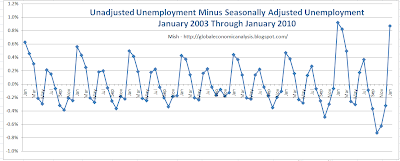BLS Seasonal Adjustments Gone Haywire; 11% Unemployment Coming by May?
Courtesy of Mish
Hi Mish
I believe the seasonal adjustment is no longer valid given that anticipated job creation down the road has not and will not be happening. I expect late spring to reverse the January effect heading into the elections. If so, a perfect political storm brewing because of their models!
Irishscot2
Irishscot2 compared the unadjusted numbers to the seasonally adjusted numbers on a percentage basis. I could not tell much from the raw data he sent, so I asked for his spreadsheet and he graciously obliged.
It is difficult to visualize raw numbers, especially trends in percentage differences, so I added a column and a couple of graphs to the spreadsheet. Here are the results.
Seasonally Unadjusted Unemployment vs. Unadjusted Unemployment
click on chart for sharper image
The above chart shows how the BLS smoothes the unemployment rate to account for seasonal trends. It also give as hint as to an increasing magnitude of that smoothing.
To highlight the month to month variances, I added a column to show the amplitude of the seasonal adjustments. The result is this chart.
Unadjusted Unemployment Minus Seasonally Adjusted Unemployment
click on chart for sharper image
Seasonal Adjustment Highlights
- There is always a big BLS adjustment in January
- There is always a reversion to the mean that overshoots to the downside between March and April
- There is always a secondary rebound back above the 0.0% line in July, followed by a smaller overshoot to the downside in October.
The problem is in the increasing amplitude of these swings, in both directions. It really makes you wonder just what the hell the BLS is doing and why.
I have data charted all the way back to 1999. Prior to January 2009, the biggest January swing was .6 percent, in both 2004 and 2003. In 2008 the January swing was only .5 percent.
The amplitude of January swings in both 2009 and 2010 was .9 percent, way outside the data range for the last 10 years, by a factor of 50 percent (.3/.6).
Likewise, the prior swings in October peaked at -.4 percent on a couple of occasions but hit -.7% in October 2009.
Unless it’s different this time (I figure it is not) a reversion to the mean that slightly overshoots in a May-June timeframe will lop off a whopping 1.3 percent off the posted seasonally adjusted rate of 9.7 percent just announced.
In other words, all things being equal (no job gains or losses), we could expect to see the unemployment rate approach 11% by May! Of course we have to factor in actual job growth (or lack thereof). We also have to factor in census bureau hiring.
Heaven knows what census hiring will do to the BLS algorithms. Your guess is as good as mine. However, whatever it does, census hiring will also revert to the mean.
Also remember that it takes 100,000 to 120,000 jobs per month just to hold unemployment rate steady. Think that’s going to happen? If so (and again discounting census hiring), then you are living in Bizarro world along with everyone else who thinks the unemployment rate is going to come crashing down.
Real World Analysis
As unbelievable as this may sound, some people do live in the real world, reporting on real data, about real jobs.
Please consider TrimTabs: Here’s Why The Real Jobs Loss Number Was 5x Worse Than What The BLS Reported
TrimTabs employment analysis, which uses real-time daily income tax deposits from all U.S. taxpayers to compute employment growth, estimated that the U.S. economy shed 104,000 jobs in January. Meanwhile, the Bureau of Labor Statistics (BLS) reported the U.S. economy lost 20,000 jobs. We believe the BLS has underestimated January’s results due to problems inherent in their survey techniques.
While the BLS originally reported job losses of 4.2 million in 2009, TrimTabs reported 5.3 million, a difference of more than a million lost jobs.
Since July 2009, TrimTabs estimates and the BLS estimates have diverged again. While the tax data points to a weak job market, the BLS estimates point to a steadily improving job market. We believe the job market is much worse than the BLS is reporting and that in January 2011, when the BLS revises their estimates for 2010, their April 2009 through December 2009 results will move much closer to TrimTabs’ results.
The BLS has seriously underreported job losses for the past two years due to their flawed methodology. TrimTabs has identified the following four problems:
1.The BLS employment estimate is based on a survey, and not on an actual count of employees. While the BLS survey is large and supposedly designed to capture the complex nature of the employment market, it is still a survey and therefore subject to error. TrimTabs believes that rapid changes in an employment cycle cannot be captured by surveys.
….
Real-Time tax withholding data shows that wages and salaries declined an adjusted 1.0% y-o-y. In January 2009, wages and salaries declined 5.0%. If the labor market were improving, we would expect a positive year-over-year growth rate. The fact that tax withholding data is still declining year-over-year suggests that the labor market is still contracting.
The BLS added a whopping 1.92 million jobs to their survey results in January. That is the spike shown in the second chart above. The number is so preposterous one might wonder if it was purposely preposterous. Census hiring may add to the preposterousness of it all, depending on what the BLS does with its models.
However, unless the administration can pull a kangaroo out of a hat, those BLS seasonal distortions will fall on the hard rocks of reality, real jobs, by real people, as opposed to figments of imagination from some very imaginative people at the BLS.




